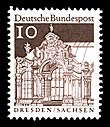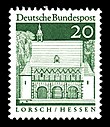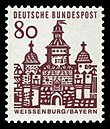German buildings from twelve centuries
German buildings from 12 centuries is the name of two German definitive stamp series that appeared from 1964 to 1969 and were partially valid until 2002.
description
The first series (I) (1964–1965) consisted of eight roughly drawn monochrome values on a white background. It appeared in rolls but was also printed in sheets . Some of the stamps were also available in stamp booklets .
The second series (II) (1966–1969) consisted of 15 (Berlin: 16) more finely executed, also monochrome, somewhat larger sheet stamps. The same values of series (I) and (II) had the same motif. The stamps were published by the Deutsche Bundespost and Deutsche Bundespost Berlin . The only difference between the Berlin values was the word “Berlin” ; Color, motif and value were the same. The publication dates of the German and Berlin editions were also the same. The Berlin stamps were valid for postage until December 31, 1991, the German issues until June 30, 2002.
Both series were designed by Otto Rohse .
particularities
- Series II appeared only in sheets. It was also the first German definitive stamp series to be produced using a uniform printing process ( intaglio printing ).
- As with all stamps that are printed in rolls and sheets, horizontal pairs and marginal pieces of Series I form a special collection area, because they can be used to prove that the stamps come from sheets. In the case of Series I, the higher value grades (from 40 Pf) were produced using intaglio printing, the lower values using letterpress printing .
- The 15 Pfennig value was the only value in Series I that did not appear in Series II. The motif ( Schloss Tegel ), however, returned in 1969 on the last issue for 1.30 DM.
- The 8 Pfennig stamp only appeared in Berlin, as this postage rate was only available there ( postcard within Berlin)
- The 30-Pfennig issue initially appeared in green, but a year later in red with the same motif to reflect the postage increase of April 1, 1967: the stamp for a standard domestic letter had to be red according to an agreement by the Universal Postal Union.
- The 1964 issue of Series I of the Bundespost had valid postage for more than 37 years and thus belong to the longest postage valid stamps in German postal history, surpassed only by a few Württemberg official and state stamps and by the Bavarian mark issue of 1874.
- Like every postage stamp series, this was also used as a value stamp for the production of postal stationery , i.e. postcards and picture postcards but also for the radio lottery postcard .
Each postage stamp in the series shows a historical German building , with gates being represented particularly often, probably to better do justice to the vertical format and the small size of the stamps.
List of issues and motives
expenditure
| image | description |
Value in pennies |
Issue date |
Output form: sheets (B), rolls (R), booklets (MH) |
Mi. -No. Bund, Berlin |
|
| Series I. | Series II | |||||
| - |

|
Berlin Gate in Szczecin | 5 | June 15, 1966 | (B) | 489 270 |
| - |

|
Pfalzgrafenstein near Kaub | 8th | June 15, 1966 | (B) | - 271 |

|
- | Wall pavilion of the Zwinger in Dresden | 10 | March 12, 1965 | (B), (R) Berlin also (MH) |
454 242 |
| - |

|
June 21, 1967 | (B) | 490 272 |
||

|
- | Tegel Castle in Berlin | 15th | March 12, 1965 | (B), (R), (MH) Berlin only (B), (R) |
455 243 |

|
- | Gate hall in Lorsch | 20th | March 12, 1965 | (B), (R), (MH) Berlin only (B), (R) |
456 244 |
| - |

|
17th November 1967 | (B) | 491 273 |
||
| - |

|
Nordertor in Flensburg | 30th | 7th January 1966 | (B) | 492 274 |
| - |

|
17th February 1967 | (B) | 493 275 |
||

|
- | Trifels Castle | 40 | March 12, 1965 | (B), (R) | 457 245 |
| - |

|
4th August 1967 | (B) | 494 276 |
||

|
- | Castle gate of Ellwangen | 50 | December 15, 1964 | (B) | 458 246 |
| - |

|
4th August 1967 | (B) | 495 277 |
||

|
- | Treptower Tor in Neubrandenburg | 60 | December 15, 1964 | (B), (R) Berlin only (B) |
459 247 |
| - |

|
April 14, 1967 | (B) | 496 278 |
||

|
- | Osthofentor in Soest | 70 | May 29, 1965 | (B), (R) | 460 248 |
| - |

|
April 14, 1967 | (B) | 497 279 |
||

|
- | Ellinger Tor in Weißenburg in Bavaria | 80 | December 15, 1964 | (B), (R) Berlin only (B) |
461 249 |
| - |

|
June 21, 1967 | (B) | 498 280 |
||
| - |

|
Zschock's monastery in Koenigsberg | 90 | June 15, 1966 | (B) | 499 281 |
| - |

|
Melanchthon House in Wittenberg | 1 DM | November 7, 1966 | (B) | 500 282 |
| - |

|
Trinity Hospital in Hildesheim | 1.10 (DM) | December 13, 1966 | (B) | 501 283 |
| - |

|
Tegel Castle in Berlin (see 15 Pf) |
1.30 (DM) | March 26, 1969 | (B) | 502 284 |
| - |

|
Town hall in Löwenberg | 2 DM | December 13, 1966 | (B) | 503 285 |
Federal German self-image and postwar
As the only postage stamp series of the Deutsche Bundespost, the stamp series also shows buildings outside the borders of the Federal Republic of Germany at the time, but also included buildings that were to be found within the borders of the German Empire on December 31, 1937 . These were in detail:
- Buildings on the territory of the GDR:
- Buildings on the territory of Poland:

- Buildings on the territory of the Soviet Union:
These stamps were objected to in the case of mailings to the GDR , Poland or the Soviet Union, often on the grounds that they violated the propaganda ban on postage stamps of the Universal Postal Union and were returned to the Federal Republic. Such letters are collected by specialists as post-war receipts.
literature
- Buildings II: The Post's permanent series concept celebrates its premiere (continuation article) In: Deutsche Briefmarken-Revue from issue no. 1/2006
- Michel Germany catalog









